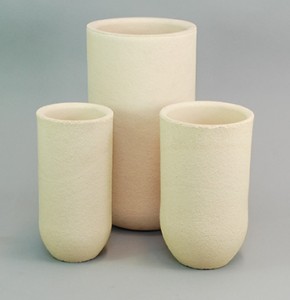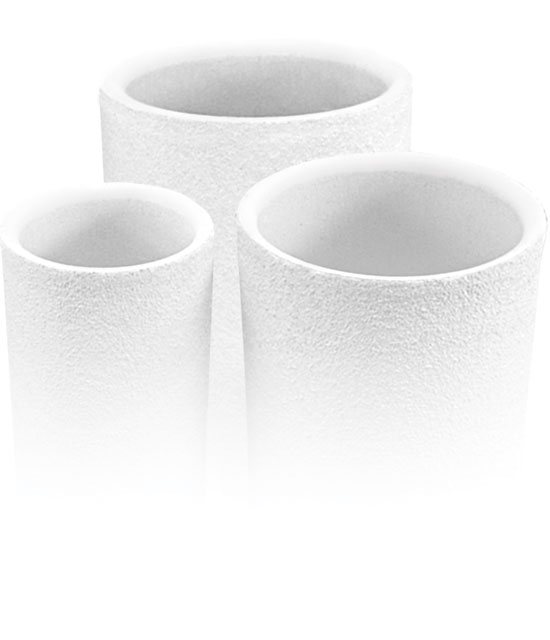 Zirconia C, M, Y, zircon
Zirconia C, M, Y, zircon
Zirconia is the most resistant oxide material to almost all metals and alloys. Zirconia crucibles are supplied in a stabilised form to lock in the crystal structure and assure good thermal cycling capabilities. Stabilising agents include CaO, MgO, Y2O3.
ZIRCONIA C, calcia (CaO) stabilised, has a very good thermal shock resistance and can be reused over several days. The ZIRCONIA C2 variant was designed for improved erosion resistance combined with a good thermal shock resistance. It is generally used for melting in air, and is suitable for steels, nickel alloys and precious metals.
For superalloys, the high performance grade is ZIRCONIA M, magnesia (MgO) stabilised. It has a fine structure and low silica content and is fired to a high temperature. This all contributes to low reactivity, with the most aggressive alloys, and high erosion resistance. Suited for the high specification alloys melted under vacuum, the products are used in the aerospace, power, medical and precious metal industries.
ZIRCONIA Y, yttria (Y2O3) stabilised, is the most stable variant for thermal cycling. Yttria has excellent resistance to reduction, reserving this version for the more testing alloys.
ZIRCONIA E is a grade used for atomising nozzles; its high purity and high density assure maximised erosion resistance under harsh conditions. As a crucible, is suited to constant conditions, such as with continuous casting and also with extremely aggressive alloys with which most crucibles will react.
ZIRCON crucibles are used for melting precious metals, especially for refining platinum group alloys applications involving glassy and siliceous slags. ZIRCON performs well with many non-ferrous metals and alloys, especially aluminium. Zircon is not “wetted” by aluminium, so is relatively unreactive; it also copes very well with thermal cycling.
Properties
Chemical Properties
| Product |
SiO2(%) |
Fe2O3(%) |
CaO(%) |
MgO(%) |
ZrO2 (%) |
Y2O3(%) |
| Zirconia C |
1.3 |
0.1 |
4.1 |
0.2 |
93.0 |
– |
| Zirconia C2 |
0.8 |
0.1 |
3.6 |
0.3 |
94.4 |
– |
| Zirconia M |
0.6 |
0.1 |
0.2 |
2.8 |
95.6 |
– |
| Zirconia Y |
0.8 |
0.1 |
0.2 |
0.2 |
90.2 |
7.2 |
| Zirconia E |
0.2 |
0.02 |
0.1 |
2.5 |
96.6 |
– |
| Zircon N |
33.0 |
0.2 |
0.1 |
0.2 |
64.5 |
– |
Physical and Thermal Properties
| Product |
AP (%) |
>BD (g/cc) |
CTE (x10-6/K) |
TC (W/m/K) |
| Zirconia C |
21.0 |
4.37 |
8.1 |
1.5 |
| Zirconia C2 |
19.0 |
4.58 |
8.1 |
1.6 |
| Zirconia M |
20.6 |
4.46 |
8.1 |
0.8-1.5 |
| Zirconia Y |
22.8 |
4.49 |
8.1 |
0.8-1.5 |
| Zirconia E |
8.5 |
5.20 |
na |
na |
| Zircon N |
13.5 |
3.80 |
4.6 |
1.7 |
AP=Apparent Porosity BD=Bulk Density CTE=Coefficient of Thermal Expansion TC=Thermal Conductivity


 Zirconia C, M, Y, zircon
Zirconia C, M, Y, zircon